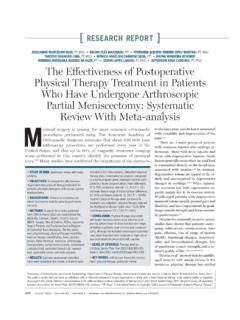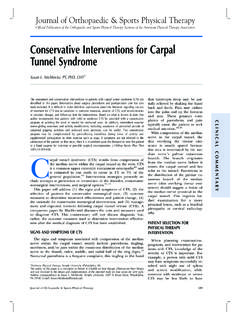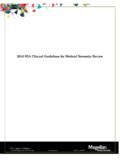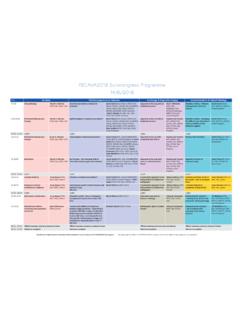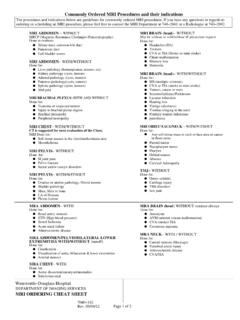Transcription of SPINE Volume 27, Number 1, pp 49–55 ©2002, …
1 SPINE Volume 27, Number 1, pp 49 55 2002, Lippincott Williams & Wilkins, of cerebrovascular IschemiaAssociated With Cervical SPINE Manipulation TherapyA Review of Sixty-Four Cases After Cervical SPINE ManipulationScott Haldeman, MD, PhD, FRCP(C),* Frank J. Kohlbeck, DC, andMarion McGregor, DC, FCCS(C), MSc Study retrospective review of 64 medicole-gal records describing cerebrovascular ischemia after cer-vical SPINE manipulation was describe 64 cases of cerebrovascularaccidents temporally associated with cervical SPINE ma-nipulation therapy in terms of patient characteristics, po-tential risk factors, nature of complication, and of Background 117cases of postmanipulation cerebrovascular ischemiahave been reported in the English language risk factors include age, gender, migraine head-aches, hypertension, diabetes, birth control pills, cervicalspondylosis, and smoking.
2 It is often assumed that thesecomplications may be avoided by clinically screening pa-tients and by premanipulation positioning of the headand neck to evaluate the patency of the vertebral researchers using a uniform data ab-straction instrument performed an independent review of64 previously unpublished medicolegal records describ-ing cerebrovascular ischemia after cervical SPINE manip-ulation. These cases were referred to a single physicianfor review over a 16-year period from across the UnitedStates and Canada. Descriptive statistics were calculatedfor characteristics of the patients and the and standard deviations were computed for con-tinuous variables.
3 Frequencies and proportions were cal-culated for categorical study was unable to identify factors fromthe clinical history and physical examination of the pa-tient that would assist a physician attempting to isolatethe patient at risk of cerebral ischemia after accidents after manipu-lation appear to be unpredictable and should be consid-ered an inherent, idiosyncratic, and rare complication ofthis treatment approach. [Key words: complications, ma-nipulation therapy, vertebral artery dissection]Spine2002;27:49 55 Manual manipulation of the cervical SPINE has been re-viewed recently by a Number of independent agenciesand commissions that have cautiously endorsed its Quebec Task Force on Whiplash- associated Disor-ders, after a review of clinical trials, described mobilizationand manipulation as effective for patients with this disorderwhile stating that there is no evidence for the effectiveness ofsuch common procedures as soft collars, corticosteroid in-jections, acupuncture, heat, ice, or muscle Corporation, in its review of published clinical trials.
4 Reported that there is evidence to support the conclusionthat cervical SPINE manipulation or mobilization may pro-vide at least short-term pain relief and range of motionenhancement for persons with subacute or chronic neckpain as well as muscle tension conclusions, together with a growing numberof prospective controlled clinical trials of varying qualityon the use of manipulation for the management of neckpain12,37 39,69and headache,2,7,11,34have led to the in-creasing acceptance and use of this treatment growing acceptance has, in turn, accented the ne-cessity to evaluate not only the effectiveness of manipu-lation, but also its potential side effects and complica-tions, the most serious of which is considered to be therisk of cerebrovascular 1934, a medicolegal abstract first noted cerebrovas-cular accidents after cervical SPINE , approximately 117 cases have been reported in theEnglish literature in 69 separate of thesearticles present single case reports or small studies of twoto five cases.
5 Krueger and Okasaki40from the MayoClinic conducted the largest case study, which included10 cases collected over a period of 15 years. These caseswere inevitably evaluated retrospectively after a patient sadmission to a hospital for brain stem, cerebellar, orcerebral ischemia . With the exception of two cases,41,56the authors did not report any attempt to contact thepractitioner of manipulation or describe any indepen-dent evaluation of data accuracy, nor have they at-tempted to assess exposure to putative risk factors asso-ciated with these complications of risk factors for vertebrobasilar artery dis-sections have included age,16,24,32,44,53,60gen-der,16,24,32,49 ,58,71migraine headaches,1,17hyperten-sion,13,16,18,23, 25,49,58,65diabetes,18,25,65birth controlpills,4,5,17,46cervical spondylosis,25,48.
6 65and has often been assumed that dissections may beavoided by screening patients clinically through appro-priate history, and by positioning of the head and neckbefore manipulation to evaluate the patency of the ver-tebral ,65An evaluation of the literature on theFrom the *Department of Neurology, University of California, Irvine,the associated Faculty, Southern California University of Health Sci-ences, the Department of Health Services, School of Public Health,University of California, Los Angeles, and Research Scientist, Rich-ardson, by a grant from National Chiropractic Mutual date: February 9, revision date: April 30, date: May 29, status category: of interest category: risk factors, precipitating manipulation, andscreening methods did not show a basis for based on review of previously publishedcase reports of various quality, however, have seriousshortcomings.
7 Access by the authors to 64 well-documented previously unpublished cases created theopportunity to evaluate the accuracy of the prior litera-ture the period 1978 1994, one of the authors ( ) wasconsulted and asked to review 64 cases in which a cerebrovas-cular ischemic event occurred after cervical SPINE manipulationtherapy. These cases involved claims of malpractice on the partof the manipulation practitioner. Because of the litigious natureand seriousness of these cases, extensive documentation anddiscovery were available for review. These cases were referredfrom both plaintiff and defense attorneys across the UnitedStates and Canada.
8 Several different malpractice insurancecompanies insured the clinicians who were the subjects of thislitigation. All the cases referred for review over the 16-year timespan were included in this study without selection as to theorigin of the referral, the validity of the malpractice claim, orthe insurance carrier involved. The referring attorneys suppliedcharts, reports, and depositions, and the reviewing author waspaid an hourly consultation fee. Table 1 shows the frequency ofeach type of data element found among the 64files. Detailsregarding patient characteristics and case specifics were com-pared with previously published case reports in an attempt toeliminate any redundant reporting.
9 The 64 cases presented inthis article represent unique incidents that, to the best of theauthors knowledge, have not been published the initial review of thefiles, a data abstraction instru-ment with specificdefinitions and terms was developed thataddressed patient medical history, onset and chronologic pro-gression of neurologic dysfunction after cervical manipulation, cerebrovascular diagnostic and treatment procedures, and se-quelae. The abstraction instrument was constructed to collectdata on the following putative risk factors: migraine, hyperten-sion, diabetes, cardiovascular disease, oral contraceptive use,smoking, cocaine and amphetamine use, recent head and necktrauma, and cervical SPINE bony pathology.
10 This instrumentwas used by three research assistants, who performed indepen-dent reviews of , the three reviewers, not including the authorwho was consulted originally on the cases, met to compare thedata from their independent reviews. Where there was dis-agreement, they revisited thefiles to reach consensus regardingfile content and information gathered. One reviewer left thestudy after the consensus process was completed on the initial53files. The same procedure was used in the analysis of 11additionalfiles, but involved only the two remaining statistics were calculated. Means and standard de-viations were computed for continuous variables.
